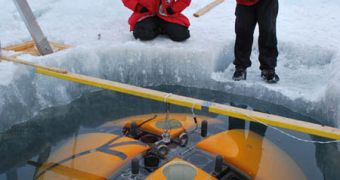Europa is perhaps the most famous moon of Jupiter, and for good reason. Data sent back years ago by the Galileo spacecraft hinted at the fact that the small world might in fact be covered in a liquid ocean, although it could be buried as deep as 100 kilometers or more under a thick ice sheet. Still, the prospect of liquid water on a distant world is much too appealing for scientists to let it slide, and so they have been looking into devising methods of studying it for a long time, Space reports.
These efforts are finally beginning to pay off, they announce, as the ENDURENCE robot has just finished its second test season successfully. The machine, called the Environmentally Non-Disturbing Under-Ice Robotic Antarctic Explorer, was put through trials at Lake Bonney, a peculiar landscape feature located in the Dry Valleys of Antarctica. The lake is composed of two “lobes” connected to each other via a narrow channel. It is covered by ice, just as the waters of Europa could be, and researchers needed to melt a hole through the cover before they could put the robot underwater.
During the experiments, the scientific instruments aboard ENDURANCE proved to work remarkably well, and researchers are hopeful that they may one day use a similar machine to explore Europa. They say that scaling back the current design is critical for this, given that the current robot weighs about 1,300 kilograms. Delivering such a heavy load as far as Jupiter is highly unlikely, provided that even the Curiosity rover, bound to go to Mars next year, is less than a ton, while being the size of a Mini Cooper. But experts are already working on other ideas other than miniaturization.
One possible option would be to create a “parent” explorer, outfitted with several mini-subs that could be operated individually. This means that the largest robot would only steer through safe locations, while producing coarse maps of its environment. Whenever an interesting structure is found, it could deploy specialized observatories, which would take high-resolution images and readings, and would also return samples to the parent explorer, for analysis. An additional problem that needs fixing is determining how to make the machine function with more autonomy, at the same time ensuring that the maximum amount of data is produced from the overall mission.

 14 DAY TRIAL //
14 DAY TRIAL //